Today’s feature comes to us from our companion service, Shooting News Weekly.
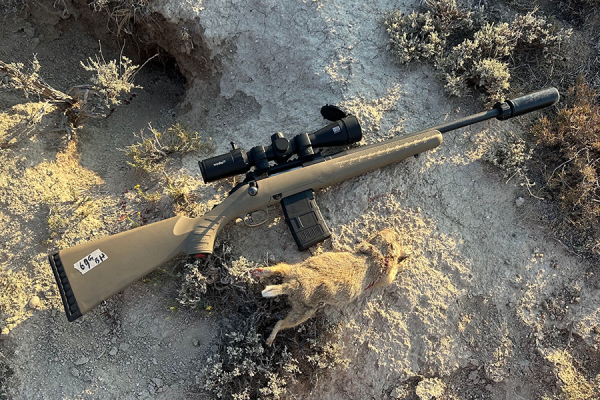
During the Great Comrade Barry gun and ammo buying panic, circa 2013 or so, I walked into my favorite gun shop and the rifle shelves were bare. Well, they were bare save for one variety of gun…bolt action rifles. Back then stock ARs were going for crazy prices if you could find one. Stripped lowers were selling for over $100. It was nuts.
A gun manufacturer would have had to be crazy during that era to put money into R&D to produce a new model of bolt-action rifle. Fortunately, that situation has changed.
Ruger American Ranch Rifles
When the panic finally subsided, companies such as Sturm, Ruger, & Co. started to realize the need for a solid, relatively inexpensive, precision bolt-action rifle that the average American can afford and appreciate.
Ruger released several chamberings in what they called the American Ranch Rifle lineup including .450 Bushmaster, a 7.62x39mm, .300 Blackout, 6.5mm Grendel, the .300 Legend, and the 5.56mm NATO. Living in Wyoming, ideal rifle country with thousands upon thousands of varmints that needed to be shot, I chose the 5.56mm version. As a quick aside, Occam Defense has some pretty cool upgrades for the Ruger 7.62x39mm Ranch Rifle.
What made all the Ranch Rifles attractive was the factory-mounted Picatinny and the use of detachable magazines. Aside from the .450 Bushmaster with its considerable muzzle brake, all the barrels are threaded for silencers. The stocks are high-strength polymer to keep down the cost, but the barrels are made with the care and precision that you would expect.
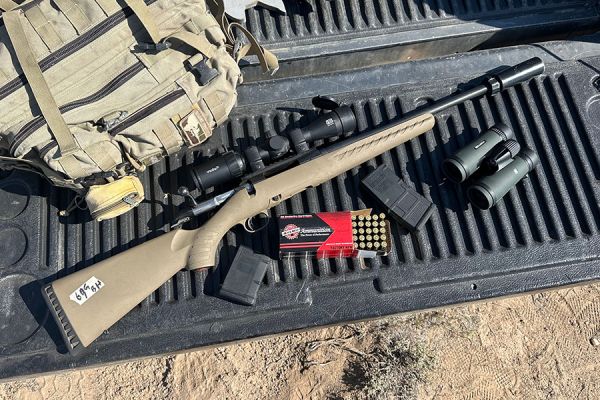
5.56mm Ranch Rifle
The first impression I had about the 5.56 Ranch Rifle was that the short action bolt was smooth and the trigger felt precise. The Ruger Marksman Adjustable trigger can be adjusted from 3 to 5 pounds. I found the trigger was just right out of the box so I felt no need to fart with it.
Another intelligent design feature was the use of a traditional AR-style floor plate and the inclusion of a 10-round Magpul PMAG. I would normally have no use for a 10-round AR magazine as I refuse to live in a blue slave state. But the 10-round PMAG in the Ranch Rifle is, in my ever-so-humble opinion, the best use for that item ever conceived.
The FDE stock feels good and shoulders well. It has a “soft rubber buttpad, crafted for maximum recoil reduction” for those who need help with the massive recoil of the ultra high powered 5.56/.223 cartridge.
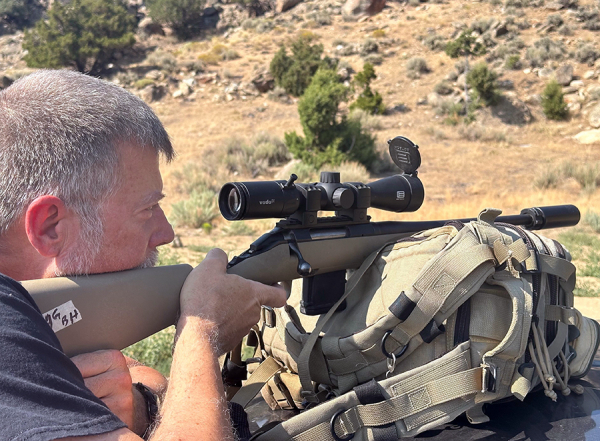
A cold hammer-forged 16.1-inch barrel was used and the action is affixed to the stock by what Ruger calls their “power bedding” process. Rifling is a 1:8 righthand twist. The rifling choice will be discussed a bit later. The bolt is a 3-lug design with a 70º throw. That means it will clear your scope without a problem and you can learn to run it rapidly. Factory threading on the barrel is traditional ½x28 TPI. The rifles come with a thread cap in place. The metal parts are finished in a matte black and the contrast with the FDE stock is aesthetically pleasing.
The decision to install the Picatinny rail in the factory versus tapping the receiver so the end user can choose their own scope bases was forward-thinking. Thanks to the popularity of ARs with Pic rail uppers, there are scores of Pic rail scope mount and ring options out there. If you really have to use your favorite brand of bases, there are other rifles out there.
The Scope: VUDU X 2-12×40 SFP
When I first picked up the Ranch Rifle I installed a rifle scope that was sitting unused on the shelf in my gun room. However, that particular optic is out of production. For this review, I decided to install a new scope that was just recently released, the VUDU X 2-12×40 SFP from EOTECH.
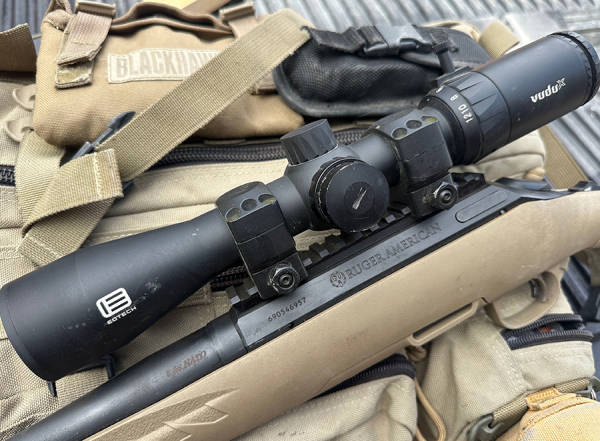
I have discussed the X line from EOTECH in previous reviews. These are a less expensive alternative to their premium VUDU line of professional grade rifle scopes. Decades ago, a mentor once said to me, “Your rifle is only as good as the scope you put on it. It makes no sense to buy a good rifle and then slap some cheap Chinese glass on it.” When I attended sniper school about twenty years ago, my instructor advised, “When it comes to glass, the scope should cost about as much as the rifle.”
As an American, you can, of course, do what you want. The VUDU X scopes are not inexpensive or “entry level.” They have good glass with premium features. I mounted the 2-12×40 SFP optic on the Ruger American Ranch Rifle with a sent of solid 30mm rings and haven’t regretted the decision.
Quiet Shooting
While you still can’t get silencers/suppressors/cans/gun-mufflers over the counter, the fact is that you can get them in record time. Just five years ago, waiting a year for the AFT to approve your tax stamp for a gun muffler was common. About a decade prior, I waited for 13 months for a .22 rimfire can to be approved! Recently, I talked to a friend and he got his suppressor approval in 4 days.

Say what you want about pistol cans, but a suppressor on a rifle is absolutely the way to go. There’s a private rifle range that I frequent here in Wyoming and all the regulars habitually use suppressed rifles. If you show up without a can on your rifle, you’re considered a d*ck and you get looks that let you know it.
The fact is that there are just way too many good suppressor makers in the United States to not use one. If you live in a slave state that forbids them, that’s a personal problem. For my Ruger American Ranch Rifle, I installed a Surefire 556. I have had this one since they were new and it was definitely worth the 11 month wait.
A rumor or misunderstanding that many folks have who do not or have not used gun mufflers is that they somehow negatively affect accuracy and velocity. That’s the exact opposite of the truth. Unless you have a strange rifle, the addition of a can to your gun should noticeably improve or tighten your groups. Yes, you will find a variance in point of impact from your unsuppressed gun to a suppressed one, but that’s to be expected. Generally, the impact change is an inch or two. Also, you can expect a slight jump/increase in velocity as well.
As my desire was to always shoot the Ranch Rifle suppressed, I put the Surefire can on and did all my range work with it in place. Which leads us to the next part of our story.
Range Testing
Part of the fun of getting a new rifle is taking it to the range with different loads and determining which one the rifle likes the best. I’ve been testing rifles for three decades and have discovered that they can and do have specific appetites for certain brands and types of ammunition. The rifling on the 5.56 Ranch Rifle being 1:8 would suggest that it should do better with heavier projectiles.
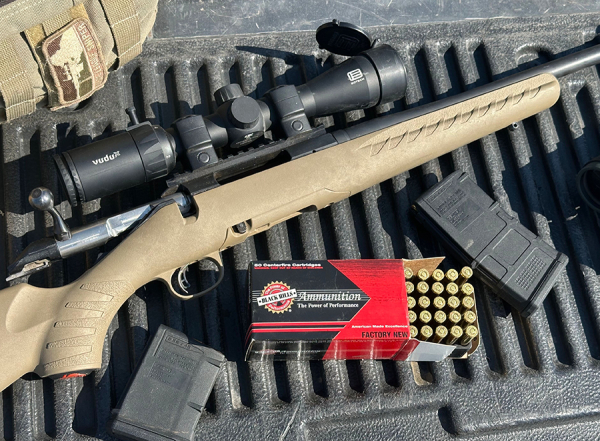
After zeroing at 100 yards, I ran a variety of 5.56mm and .223 Remington rounds through the gun and found that all of them posted 3-shot groups in the 1.5 to 1-inch range as long as I did my part. The winner, however, was Black Hills 5.56mm 69 grain OTM load. Using the BH load, I found that the 69 grain load regularly posted sub-MOA groups on demand. Average 100-yard 3-shot groups were around ¾ of an inch. If I did my part, often two of the holes would be touching. For a factory rifle, you can’t ask for better performance.
Field Time
From late April to September, the ranch land and fields in Wyoming are teeming with prairie dogs, a bane to ranchers whose $3000 steers or cows sometimes step in the holes and break their legs. Don’t even get me started on a saddle horse breaking a leg in a prairie dog hole. A well-trained, saddle-broken horse can be a $10,000 investment. Wyoming cowboys hate prairie dogs.
If you are friendly with the local rancher, they love to have you to cull the pests. There are also thousands upon thousands of acres of wide-open BLM land on which you can hone your skills.
A resident furbearers permit isn’t that expensive in Wyoming and that opens up your summertime hunting to coyotes and badgers as well. For prairie dogs and jack rabbits — another pest species — no permit is needed. Rock chucks are a challenging target of opportunity as they don’t just let you walk up on them.
Shortly after zeroing the rifle with the VUDU X scope, I took to the fields with great alacrity and exuberance. Soon I was stacking varmints and pests to the point that I actually lost track of the numbers. For the uninitiated, a prairie dog averages the size of a 16-ounce Coke bottle when standing up. Your aim must be true and your rifle must be dead-on for accuracy.

During a recent outing, I took my son-in-law with me and gave him the Ranch Rifle and a couple of boxes of Black Hills fodder. He had taken a precision rifle class a couple years prior and was pleased to be able to put his skills to test.
Parting Shots
While I can’t attest to the function of the other rifles in the American Ranch Rifle lineup, I can say that the 5.56 Ranch Rifle from Ruger is a fantastic tool for field work. With all the focus on plastic-framed pistols and ARs, it’s nice to step away sometimes and just focus on single, well-aimed shots.
With all of the firearms in Ruger’s catalog, it might be easy to overlook the American Ranch Rifle series. While they might not be as “cool” or “sexy” as the pistols and autoloading rifles, there is definitely a place for them in your gun locker. And the fact that they retail for about $450makes them even more attractive. For North American game up to medium size, this might just be the ticket for you, particularly if you use the right load.
Specifications: Ruger American Ranch Rifle
Caliber 5.56
Action 3 Lug Bolt (short)
Capacity 10 rounds (others)
Barrel Length 16.1 inches
Overall Length 36 inches
Weight (empty) 6.1 pounds
Stock: Polymer
MSRP: $669 (about $450 retail)
— Paul G. Markel
Paul G. Markel is the founder of Student the Gun University and has been teaching Small Arms & Tactics to military personnel, police officers, and citizens for over three decades. He is the author of numerous books and is a combat decorated United States Marine veteran.